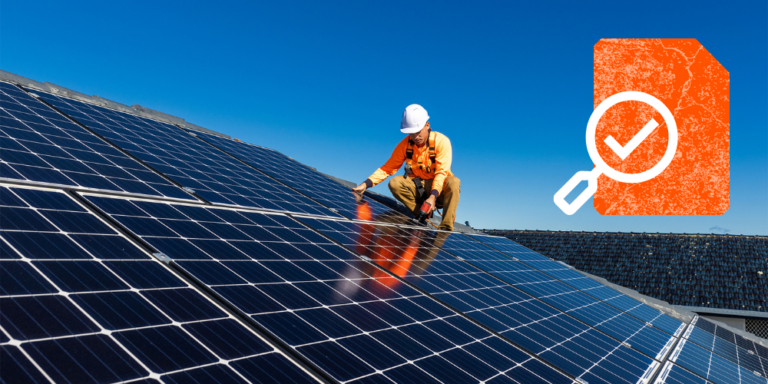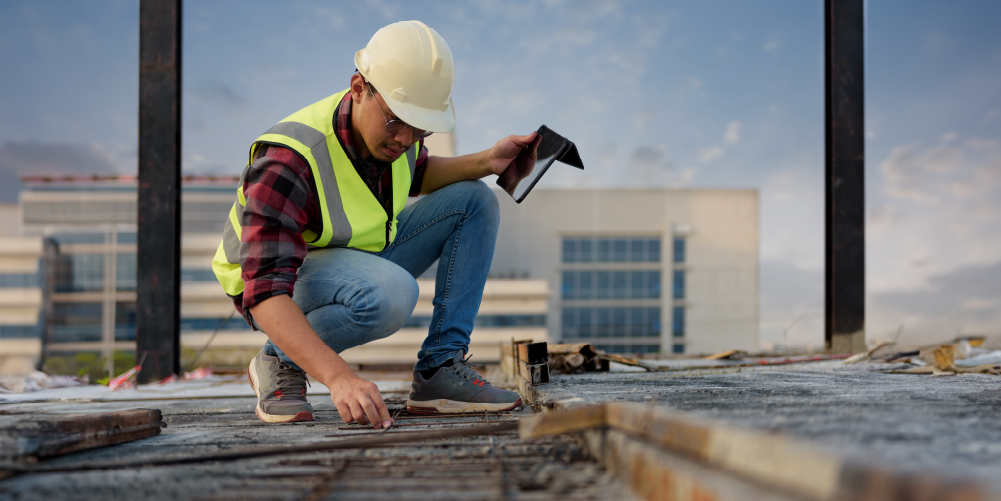— 6 min read
Optimizing Solar Inspections: A Construction Pro’s Guide
Last Updated Mar 31, 2025
Last Updated Mar 31, 2025

As solar power becomes more prevalent in both residential and commercial projects, construction contractors and project owners will need to become more familiar with solar installation projects. Solar inspections — professional evaluations that check the installation, safety, efficiency and performance of solar power systems — are a key part of the installation process.
This article will explore the value of solar power inspections in assessing safety and compliance and detecting issues that interfere with optimal performance. It will also cover the different types of inspections, methods used and best practices to help industry professionals effectively manage solar construction.
Table of contents
The Importance of Solar Inspections
Solar installations, from small residential to massive commercial farms, require inspections before activation and periodically throughout their life cycle. Some inspections are required by local or national authorities, while others help owners maintain their systems.
Safety and Risk Mitigation
Inspections on a solar power system are critical because these power-generating systems are designed to be in use for an extended period of time — sometimes more than two decades.
Because of this, solar projects require detailed inspection items such as ensuring torque marks are visible, or there are no loose connections that can cause damage to the electrical system. Making sure that each component of the plant has been carefully inspected and has proper LOTO (Lock Out Tag Out) systems in place is very important to the overall long-term safety and efficiency of the project.
Compliance with Codes and Regulations
Solar installations need to comply with electrical, interconnection and building codes and standards. Inspectors assess compliance with structural, fire safety, setback and load requirements such as seismic or wind.
The design and installation must also comply with all electrical codes, including the National Electrical Code Article 690. Interconnection with the grid and all components of the solar PV (photovoltaic) system must meet safety requirements.
Maximizing Energy Production and Efficiency
Issues that prevent maximum energy output can include faulty components, faulty fuses, shade, physical damage or improper installation. Inspections can help installers and owners mitigate issues to maximize the system's energy production.
Early Detection of Problems
Due to the repetitive nature of the work, uncovering problems and addressing minor issues promptly during the install can mitigate costly rework and repairs on a large scale. Inspections help owners avoid unexpected repair costs and identify action items for preventative maintenance.
Types & Timing of Solar PV Inspections
Different types of inspections help installers and owners evaluate the condition and performance of solar power systems. The specialized parts of systems can include panels, inverters and other electrical components that require knowledgeable professionals to assess the safety and efficiency of the system properly.
Before energization of the plant, solar power installations need to be inspected, but there are other times when inspections are required or recommended.
Pre-Installation Inspection
Before installing solar PV panels, the site or structure must be surveyed and checked to make sure the electrical system can handle the added load. For solar farms, choosing a geographic site involves assessing the topography, access to sunlight, proximity to electrical infrastructure, the feasibility of construction and checking the zoning for permits and interconnect agreement availability.
The biggest legal aspect needed before you start the project is applying for the interconnect agreement — whether it's residential or commercial — and checking with the utility company to see if they have the capacity on the grid to put this much energy onto the grid. Sometimes, they have to upgrade transformers and substations, so they need to know what you plan to do.
Rachael Ceciliani
Senior Strategic Product Consultant
Procore Technologies
Post-Installation Inspection
Once the panels are installed, inspections verify the correct installation and the safety of the system's components. Inspectors check documentation and execute performance testing before commissioning the solar PV system.
Inspections for Regular Maintenance
Periodic maintenance inspections should be performed at least annually, checking the system's wear and tear, efficiency and safety. The ideal frequency of solar PV inspections depends on location, weather conditions and system age.
Methods of Solar Inspection
Various inspection methods are employed to confirm solar photovoltaic systems operate safely and efficiently, each using different techniques and technologies to assess components and identify potential issues.
Visual Inspections
Visually check panels, torqued bolts, mounting and physical damage.
Electrical System Checks
Examine wiring, connections, grounding, LOTO and other electrical components for safety and compliance.
Thermal Imaging
Hand-held or drone-mounted cameras measure temperature variations to detect hot spots or other electrical problems.
Drone Inspections
Drones can take photos and perform thermal imaging on large solar arrays.
Performance Evaluation
These evaluations determine energy output and efficiency and often include I-V curve testing to validate the system's performance and health.
Solar Inspection Tools & Technologies
Advanced technologies are increasingly valuable for designing, monitoring and documenting solar power installations to make inspections and maintenance easier. Here are some of the tools companies are employing to support efficient management of solar PV systems.
Drones
Using drones equipped with different cameras helps inspect large or inaccessible solar arrays. Drones can capture high-resolution images to perform detailed visual inspections without the danger of workers accessing the panels. Infrared cameras and thermal sensors can detect defects or hotspots.
Specialized Software
Solar design and simulation software has features that allow engineers and installers to optimize systems. Other software can process drone-captured data for site surveys or inspections.
Monitoring software can track system performance in real time, providing data for the early detection of defects or maintenance needs. Using software allows data collection for documentation necessary for compliance and reporting.
Build a Strong Foundation with our Preconstruction Course
With 20+ years of experience, Ben Ashburn teaches you how to streamline planning, bidding, and procurement for better outcomes.

Best Practices for Solar Power Inspections
Inspections before installation or activation and when the system is operational isn't just a critical item — it's often a requirement. Inspections help optimize system performance and mitigate safety risks. Here are some best practices to make them more beneficial and efficient.
Scheduling and Timing
Schedule inspections on clear, sunny days for the best visual access and to assess performance accurately, and is often a requirement. Implement a maintenance and inspection plan to catch problems early.
Monitoring and Compliance
Use updated monitoring technology to assess performance and spot faults continuously. Real-time visibility into performance helps manage the system, make data-driven decisions and provide authorities with necessary data for inspections. Create and keep logs and inspection documentation.
Inspection Safety
Properly trained inspectors — whether outside professionals or company staff — must follow all safety protocols because of the electrical hazards inherent in solar installations. Personnel need to fully understand the system and be trained how to operate it to perform inspections and maintenance.
Electricians are probably your most highly specialized trade. Many electricians know about DC power but don't touch it often. The problem with DC power is that it's not as stable as AC power. The inverters can catch fire. The combined boxes can catch fire.
Electrical safety involves lockout/tagout procedures because you have a live current anytime the panel is facing the sun. If you have electricians that aren't trained or companies that don't have proper safety procedures, you can run into problems.
Rachael Ceciliani
Senior Strategic Product Consultant
Procore Technologies
Boost Safety, Compliance and & System Efficiency With Inspections
Incorporating regular and thorough inspections into solar system management ensures long-term reliability and efficiency. Authorities require solar PV system inspections at certain stages, but inspections can also be a tool for optimizing performance and saving money by prioritizing maintenance.
As solar technology evolves, staying informed about inspection techniques and tools can help owners and contractors maximize system performance, increase longevity and enhance safety.
Was this article helpful?
Thank you for your submission.
0%
0%
You voted that this article was . Was this a mistake? If so, change your vote here.
Scroll less, learn more about construction.
Subscribe to The Blueprint, Procore’s construction newsletter, to get content from industry experts delivered straight to your inbox.
By clicking this button, you agree to our Privacy Notice and Terms of Service.
Categories:
Tags:
Written by
Julia Tell
45 articles
Julia Tell is a freelance writer covering education, construction, healthcare, and digital transformation. She holds a Ph.D. in Media & Communications and has written for publications including Business Insider, GoodRx, and EdSurge, as well as nonprofits, international businesses, and educational institutions.
View profileReviewed by
Rachael Ceciliani
Rachael is a Strategic Product Consultant for Procore who has been in the construction industry since 2013, spending 8+ years with McCarthy Building Companies and growing her expertise as a construction project manager.
View profileExplore more helpful resources

Using a Rough-in Inspection Checklist (Guide & Free Download)
One of the most common significant milestones in a construction project is the rough-in inspection. Rough-ins are the formal checks of important systems — such as electrical, plumbing and HVAC...

The Ultimate Guide to Managing Commercial Construction Inspections
Commercial construction projects require ongoing inspections at almost every point of the building process, from checking the site before construction to the final inspection with a local building authority. Understanding...

The Contractor’s Guide to Concrete Inspections
Concrete: It’s the key building block of nearly every structure’s foundation — and it’s the world’s most widely used building material. For most general contractors, understanding how to assess concrete...

How to Understand and Use Architect’s Supplemental Instructions
Architect’s supplemental instructions, also known as ASI, offer a means of making small changes to the construction contract after it’s signed. The ASI is a document issued by the architect...